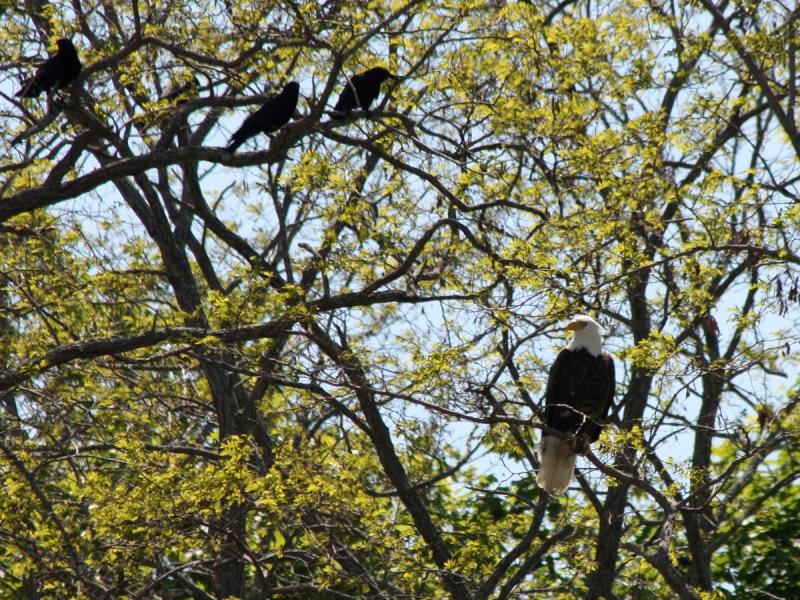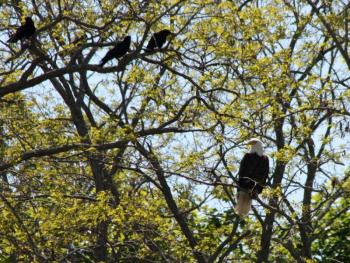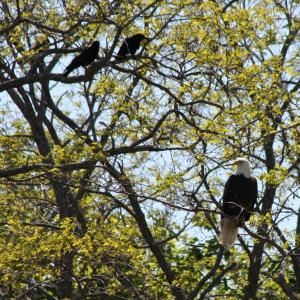Henry Laurita: The crow — social and intelligent
As we settle into the brunt of winter and the winds feel more biting every day, I think it’s a good time to remember our outdoor neighbors.
The forest seems barren this time of year. The songs of the warblers have warbled their way south (some as far as the Andes in South America) and many mammals have hunkered down against the cold. Of the creatures that remain behind or above ground, perhaps none of them stand out against the winter whiteness like the crow; however, there is far more that sets them apart from other animals than their color.
The crow is a remarkably intelligent and social animal.
It’s easy to forget about the minds in the animal kingdom, yet every time you drive to work or take a walk in the woods, you’re stepping into the world next to another species that learns, solves problems, leads a complex social life, and thrives next to you.
Individuals are capable of producing 250 different sounds used for communication, and in winter they congregate into groups, or “murders”, of up to 1,000 strong. This is perhaps why crows can be so successful in winter; a lot can be said with a vocabulary of 250 sounds, and information passes swiftly in a chatty colony of hundreds.
Information on available food, coming predators, or newly discovered tools can be exchanged and acted upon. Remarkably, crows all over the world have demonstrated the ability to create and use tools for tasks like finding food or cleaning their beaks.
Recent studies have even shown crows teach each other how to use these items. Parents may leave discarded tools around the nest while their offspring grow up, giving the inquisitive minds of young crows something to experiment with.
Much of the crow’s intelligence comes from its ability to observe. For hundreds of years, ice-fishermen have battled the crow who, watching from afar, has learned that fish are kept on the ends of those strings. The crow will wait for an opportunity and kindly pull the trap and remove the fish.
This knowledge, along with much else, will be passed down to the next generation of crows, in an accumulation of understanding that can only be called culture.
The Common, or American, Crow we have in Maine (Corvus brachyrhynchos) is one of about 30 Corvus species in the world.
In Maine, the crow’s range overlaps with that of its relative — the raven. Both are highly intelligent, large-beaked, populous and easily confused with each other. Ravens, however, typically travel in pairs whereas crows go about in larger numbers.
If you are ever lucky enough to see them near each other, the crow will be the smaller of the two.
In flight, the crow’s tail is shaped like a fan, while the raven has a telltale wedge or spade shape. When walking, ravens adopt a curious, staggered two-footed hop. They can travel rather swiftly in this shambling manner. By ear, the raven can be distinguished by its throaty gurgle from the crow’s more piercing caw. Both birds have a wide vocal range, so identification by sight is less fallible.
Crows, rats and a few other animals are synanthropomorphic species, meaning that they successfully exist alongside humans.
Crows are quickly finding that urban and suburban areas are places full of opportunity, and now the majority breed within three miles of these areas. As we expand and change, i’s important to remember crows are right there with us. Their brains are proportionally as large as a chimpanzees and researchers are constantly uncovering just how smart they are.
A recent study puts their intelligence near that of the Great Apes. That, of course, is an estimation prone to error — the mind of a bird must work in ways hard for us mammals to understand.
It’s easy to forget about the minds in the animal kingdom, yet every time you drive to work or take a walk in the woods, you’re stepping into the world next to another species that learns, solves problems, leads a complex social life, and thrives next to you.
Observing the crow, particularly in large numbers, is very amusing. Few animals are so curious or playful. Be warned however, that if you watch them for a while, they most certainly will be watching you back.
Event Date
Address
United States




























